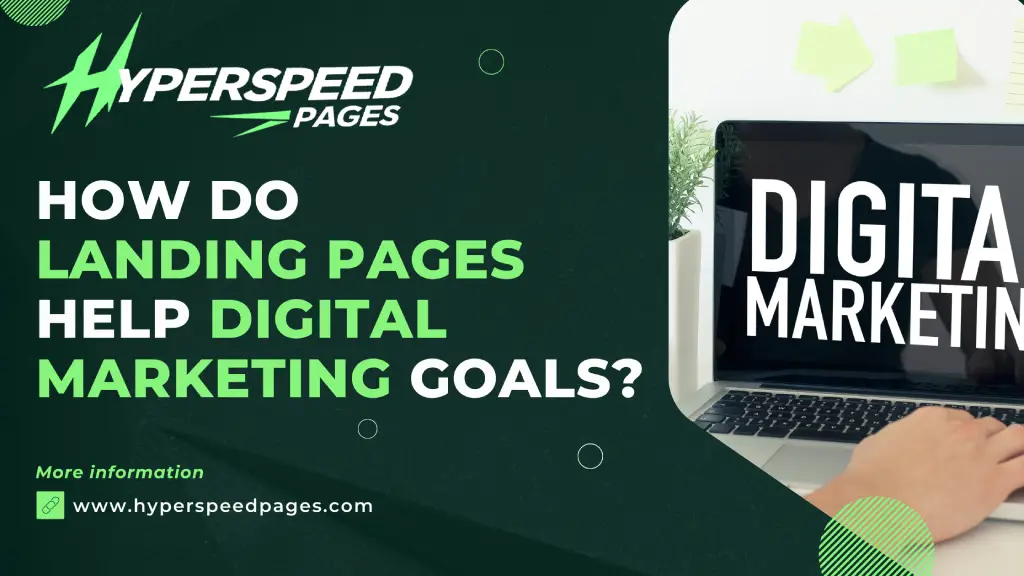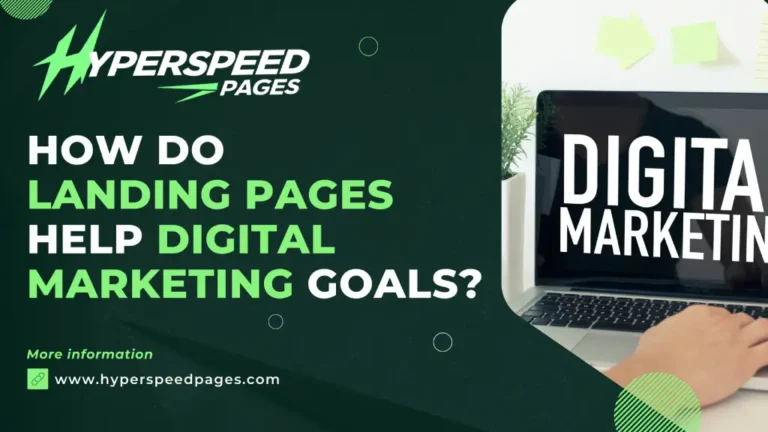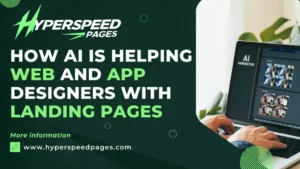
Digital marketing is the backbone of modern business growth. Whether you’re driving brand awareness, generating leads, or converting prospects into customers, achieving your marketing objectives requires a strategic approach—and landing pages are a critical part of the strategy. These specialized pages are designed to guide visitors toward a specific goal, making them indispensable tools for marketers.
Let’s explore how landing pages help digital marketing goals, why they matter, and how you can leverage them to transform your campaigns.
What Are Landing Pages?
A landing page is a standalone web page created specifically for a marketing or advertising campaign. Unlike regular website pages, which can have multiple purposes, landing pages focus on a single, well-defined objective.
Typically, landing pages feature:
- A compelling headline that grabs attention.
- Clear and concise content designed to inform or persuade.
- A strong call-to-action (CTA) encourages visitors to take a specific action, such as filling out a form, downloading a resource, or making a purchase.
- Minimal navigation or distractions, ensuring the visitor’s attention stays on the offer.
These characteristics make landing pages incredibly effective at converting traffic from various channels into tangible results.
Why Are Landing Pages Essential in Digital Marketing?
In the competitive world of digital marketing, every click and conversion counts. Here’s why landing pages are crucial:
They Drive Higher Conversion Rates
Landing pages are purpose-built to convert. Unlike homepages or blog posts, which often serve multiple functions, landing pages have a singular focus, eliminating distractions and guiding visitors toward a specific action.
For instance, a software company promoting a free trial can use a landing page to highlight the trial’s benefits and include a clear “Sign Up Now” button. By aligning the content with the visitor’s intent, landing pages can significantly increase conversion rates.
They Support Marketing Campaign Goals
Every marketing campaign has a goal—whether it’s generating leads, promoting a product, or increasing event registrations. Landing pages are tailored to these objectives, ensuring consistency between the campaign’s messaging and the user experience.
For example:
- A PPC ad promoting a discount might link to a landing page featuring the offer details and a countdown timer to create urgency.
- An email campaign about a new product launch can direct recipients to a landing page showcasing the product’s features and an option to pre-order.
By creating landing pages for specific campaigns, marketers can deliver a cohesive and engaging experience that moves users closer to conversion.
They Improve Lead Generation
Lead generation is at the heart of many digital marketing strategies, and landing pages excel at capturing leads. By offering something valuable in exchange for contact information—such as an eBook, a webinar, or a discount—marketers can build robust email lists and nurture potential customers.
The simplicity of landing pages ensures that visitors focus on the lead capture form, increasing the likelihood of conversion.
How Landing Pages Integrate with Digital Marketing Channels
Landing pages are versatile tools that amplify the effectiveness of various digital marketing channels. Let’s explore how they work in tandem with these channels:
Search Engine Advertising (PPC)
Pay-per-click (PPC) advertising is one of the most effective ways to drive targeted traffic. However, the success of a PPC campaign depends on where that traffic lands.
Landing pages designed for PPC campaigns:
- Match the ad’s intent: By aligning the headline and content with the ad copy, landing pages create a seamless user experience.
- Feature a clear CTA: Encouraging users to take immediate action, such as signing up or purchasing.
- Improve Quality Score: Platforms like Google Ads reward high-quality landing pages with better ad placements and lower costs.
For example, a PPC ad promoting a “free consultation” should direct users to a landing page with a simple form and an easy way to schedule the consultation.
Email Marketing
Emails are a powerful way to nurture leads and keep your audience engaged, but they’re only as effective as the actions they inspire. Linking emails to landing pages helps bridge the gap between interest and action.
Effective email campaigns use landing pages to:
- Provide additional information about an offer or event.
- Capture registrations for webinars, courses, or product demos.
- Encourage users to redeem discounts or download resources.
By driving traffic to dedicated landing pages, email campaigns can achieve higher click-through and conversion rates.
Social Media Campaigns
Social media platforms are excellent for driving awareness and engagement, but they often require the next step to convert interest into results. That’s where landing pages come in.
Social media campaigns can link to landing pages that:
- Highlight special promotions or giveaways.
- Capture user information through contests or sign-ups.
- Provide detailed information about products or services.
For instance, a fashion brand running a summer sale on Instagram could link its bio or ads to a landing page showcasing the sale items and a “Shop Now” button.
Content Marketing
Content marketing focuses on delivering value to your audience through blog posts, videos, infographics, and more. Landing pages complement this approach by offering related resources or next steps.
For example:
- A blog post about time management might link to a landing page offering a free productivity planner download.
- A YouTube video explaining a product’s features could direct viewers to a landing page with pricing details and a purchase option.
By integrating landing pages into content marketing strategies, businesses can guide users from passive consumption to active engagement.
Best Practices for High-Converting Landing Pages
Creating effective landing pages requires more than just good design. Here are some best practices to follow:
Start with a Clear Goal
Every landing page should have a single, well-defined goal. Whether it’s collecting email addresses, promoting a product, or encouraging sign-ups, the goal will dictate the page’s content, layout, and CTA.
Craft a Compelling Headline
Your headline is the first thing visitors see. Make it clear, attention-grabbing, and relevant to the campaign. A strong headline should:
- Highlight the value proposition.
- Align with the source of traffic (e.g., the ad or email).
- Create curiosity or urgency.
Keep It Simple
Landing pages work best when they’re free of distractions. Remove unnecessary navigation menus, links, or clutter that might take the visitor’s focus away from the CTA.
Use High-Quality Visuals
Images and videos can make your landing page more engaging, but they should support the message rather than overshadow it. Use visuals that are:
- Relevant to the offer.
- Optimized for fast loading.
- Positioned strategically to guide users toward the CTA.
Include Social Proof
Trust is a crucial factor in conversions. Adding testimonials, reviews, or trust badges can reassure visitors and boost credibility.
Optimize for Mobile
With more users browsing on smartphones, mobile optimization is non-negotiable. Ensure your landing page:
- Loads quickly.
- Has easily clickable buttons.
- Displays forms and content properly on smaller screens.
Measuring the Success of Your Landing Pages
To ensure your landing pages are helping you achieve your digital marketing design landing page goals, it’s essential to track key performance metrics:
- Conversion Rate: The percentage of visitors who complete the desired action.
- Bounce Rate: A high bounce rate could indicate that the landing page isn’t meeting user expectations.
- Traffic Sources: Knowing where your visitors are coming from helps refine your marketing efforts.
- Form Completion Rate: For lead generation pages, this metric reveals how many visitors are filling out forms.
Analyzing these metrics allows you to identify strengths and weaknesses, helping you improve your landing pages over time.
How Hyper Speed Pages Can Help
At Hyper Speed Pages, we understand the critical role landing pages play in digital marketing success. That’s why we specialize in creating lightning-fast, conversion-focused landing pages that drive results.
Our team of experts works closely with businesses to design pages that:
- Align with your brand and campaign goals.
- Optimize user experience for higher engagement.
- Deliver measurable outcomes, whether it’s lead generation, sales, or awareness.
With Hyper Speed Pages, you can focus on scaling your marketing efforts while we handle the technical details.
How Landing Pages Boost Retargeting Campaigns
Retargeting, or remarketing, is a powerful digital marketing strategy that allows businesses to re-engage users who have previously interacted with their brand. Landing pages play a pivotal role in ensuring the success of retargeting campaigns by providing tailored experiences for these highly targeted audiences.
Reinforce Prior Engagement
Landing pages for retargeting campaigns can remind users of products they’ve browsed or offers they’ve shown interest in. For example:
- A visitor who abandoned their cart on an e-commerce site can be retargeted with a landing page offering a discount to complete their purchase.
- A user who visited a webinar sign-up page but didn’t register can be directed to a landing page with additional details and a simplified registration form.
These personalized touches can reignite interest and move users further down the sales funnel.
Enhance Message Consistency
Retargeting ads often highlight specific products, services, or promotions. Directing users to a landing page that mirrors the ad’s message creates a seamless experience, reinforcing trust and encouraging action.
For instance, if an ad emphasizes “20% off your first order,” the landing page should prominently display this discount and make it easy for users to claim it.
Increase Return on Investment (ROI)
Since retargeting focuses on users who have already expressed interest, the traffic driven to landing pages is often highly qualified. Well-designed landing pages can capitalize on this interest, delivering higher conversion rates and improving the ROI of retargeting campaigns.
By integrating landing pages into your retargeting strategy, you can nurture hesitant buyers, rebuild trust with lost leads, and drive measurable results.
Conclusion
Landing pages are more than just standalone web pages—they’re powerful tools that help marketers achieve their digital marketing goals. By focusing on specific objectives, integrating with various channels, and following best practices, landing pages can drive higher conversions, capture leads, and support long-term business growth.
Whether you’re launching a new product, running a PPC campaign, or growing your email list, landing pages are your secret weapon for success. Ready to take your marketing efforts to the next level? Start creating optimized landing pages today and watch your results soar.




